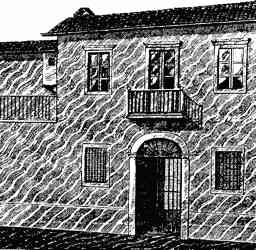 |
Science Frontiers ONLINE No. 77: Sep-Oct 1991 |
|
|
Eclipse shadow-band anomalies
 Shadow bands moving across the face of a house during the total eclipse of December 22, 1870. |
"There mysterious gray ripples are sometimes seen flitting over the ground within a minute or two of to tality. The bands are initially faint and jumbled; but as totality approaches, they become more organized, their spacing decreases to a few centimeters, and their visibility improves. After totality ends the bands can reappear and become progressively fainter and more disorganized until they disappear."Shadow bands seem to move perpendicularly to their length, but this is only an illusion. It stems from a lack of features that allow the eye to track motion along the length of the bands."
Codona explains the shadow bands as basically a twinkling effect involving the thin solar crescent just before and after totality. The twinkling is created by turbulence only tens or hundreds of feet above the ground.
The eclipse shadow bands, like so many other "well-explained" phenomena, display idiosyncracies that do not dovetail well with theory. Codona mentions two of these: (1) Bands of different colors, travelling at different speeds, are sometimes seen superimposed on each other; and (2) Bands of giant size have been observed. (Codona, Johana L.; "The Enigma of Shadow Bands," Sky and Telescope, 81: 482, 1991.)
Comment. Still other shadow-band anomalies are cataloged in GES1, in Rare Halos, Mirages. This catalog is described here.